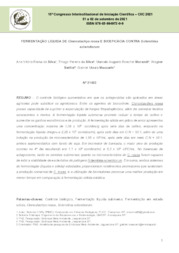Fermentação líquida de Clonostachys rosea e bioeficácia contra Sclerotinia sclerotiorum.
Fermentação líquida de Clonostachys rosea e bioeficácia contra Sclerotinia sclerotiorum.
Author(s): SILVA, A. V. R. da; SILVA, T. P. da; MORANDI, M. A. B.; BETTIOL, W.; MASCARIN, G. M.
Summary: Resumo: O controle biológico aumentativo em que os antagonistas são aplicados em áreas agrícolas pode substituir os agrotóxicos. Entre os agentes de biocontrole, Clonostaschys rosea possui capacidade de suprimir a esporulação de fungos fitopatogênicos, além de colonizar tecidos senescentes e mortos. A fermentação líquida submersa promete reduzir o tempo de cultivo e aumentar os ganhos econômicos e de produção. A fermentação sólida em grãos de arroz apresentou uma concentração máxima de 1,09 x 109 conídios/g após sete dias de cultivo, enquanto na fermentação líquida chegou a 2,28 x 109 conídios/mL após sete dias em C:N = 50:1, além de uma indução na produção de microescleródios de 1,66 x 104 /mL após sete dias em meio C:N = 10:1, ambos suplementados com farelo de soja. Em biorreator de bancada, o maior pico de produção ocorreu no 4º dia resultando em 1,1 x 109 conídios/mL e 5,2 x 108 UFC/mL. No bioensaio de antagonismo, tanto os conídios submersos quanto os microescleródios de C. rosea foram capazes de inibir a viabilidade de escleródios do patógeno Sclerotinia sclerotiorum. Em suma, ambos sistemas de fermentação (líquida e sólida) estudados proporcionam rendimentos promissores que sustentam a produção comercial de C. rosea, e a utilização de biorreatores promove uma melhor produção em menor tempo em comparação à fermentação sólida-estática. -- Abstract: Augmentative biological control in which antagonists are applied to agricultural crops can replace chemical pesticides. Among the biocontrol agents, Clonostaschys rosea has the ability to suppress the sporulation of plant pathogenic fungi, in addition to rapidly colonizing senescent and dead plant tissues. Submerged liquid fermentation enables to reduce the cultivation time while economically increasing the yields. In this study, solid fermentation in rice grains showed a maximum concentration of 1.09 x 10 9 conidia/g after 7 days of cultivation, while in liquid fermentation it reached 2.28 x 10 9 conidia/mL after 7 days at C:N = 50:1, but also induced the production of microsclerotia up to 1.66 x 10 4 /mL after 7 days in medium C:N = 10:1, both supplemented with soyflour. In order to improve production, fermentation batches carried out in a benchtop bioreactor promoted the production peak on the 4 th day, corresponding to 1.1 x 10 9 conidia/mL and 5.2 x 10 8 CFU/mL. For the bioassay, both submerged conidia and microsclerotia of C. rosea were able to inhibit 100% viability of sclerotia of Sclerotinia sclerotiorum. Therefore, both fermentation systems (liquid and solid) tested here provide high yields that support the commercial production of C. rosea and the use of bioreactors improves spore yields in shorter time than the solid-state fermentation.
Publication year: 2021
Types of publication: Paper in annals and proceedings
Unit: Embrapa Environment
Related content
Observation
Some of Embrapa's publications are published as ePub files. To read them, use or download one of the following free software options to your computer or mobile device. Android: Google Play Books; IOS: iBooks; Windows and Linux: Calibre.
Access other publications
Access the Agricultural Research Database (BDPA) to consult Embrapa's full library collection and records.
Visit Embrapa Bookstore to purchase books and other publications sold by Embrapa.

